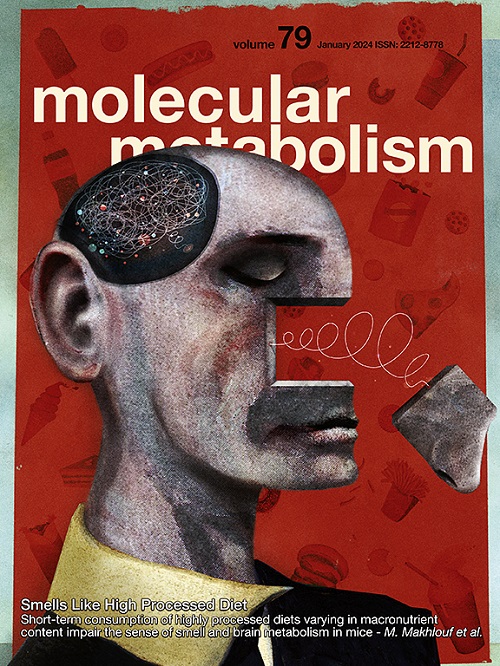单核mrna测序揭示了小鼠棕色脂肪组织中脂质生成和产热脂肪细胞群在冷暴露下的动态变化。
IF 6.6
2区 医学
Q1 ENDOCRINOLOGY & METABOLISM
引用次数: 0
摘要
棕色脂肪组织(BAT)包括脂肪细胞和非脂肪细胞类型的异质群体。为了表征这些细胞亚群及其对寒冷的适应性,我们对室温或暴露于急性(24小时)或慢性(10天)寒冷(6°C)的小鼠的肩膜间BAT进行了单核mrna测序(snRNA-seq)。为了研究从头脂肪生成(DNL)调控转录因子碳水化合物反应元件结合蛋白(ChREBP)的作用,我们分析了对照小鼠和棕色脂肪细胞特异性ChREBP敲除小鼠。我们鉴定了不同的细胞群,包括7种具有不同代谢谱的棕色脂肪细胞亚型。其中一株高表达ChREBP和DNL酶。值得注意的是,这些脂质脂肪细胞对急性冷暴露高度敏感,在对照小鼠中显示出BAT的明显减少,这被其他维持DNL的棕色脂肪细胞亚型所补偿。慢性冷暴露导致基底棕色脂肪细胞和推定来源于基质和内皮前体细胞的脂肪细胞的扩张。在chrebp缺陷小鼠中,在所有条件下几乎都没有脂质脂肪细胞,这表明转录因子是这种脂肪细胞亚型的关键决定因素。详细的表达分析显示Ttc25是脂质棕色脂肪细胞的特异性标记物,也是ChREBP的下游靶点。此外,通路和细胞间相互作用分析表明,Wnt- chrebp轴与脂质脂肪细胞的维持有关,来自基质细胞和肌肉细胞的Wnt配体提供了指导性线索。我们的研究结果提供了BAT细胞异质性的全面图谱,并揭示了ChREBP在脂质脂肪细胞特性中的关键作用,以及对BAT可塑性和代谢功能的影响。本文章由计算机程序翻译,如有差异,请以英文原文为准。
Single-nucleus mRNA-sequencing reveals dynamics of lipogenic and thermogenic adipocyte populations in murine brown adipose tissue in response to cold exposure
Objective and methods
Brown adipose tissue (BAT) comprises a heterogeneous population of adipocytes and non-adipocyte cell types. To characterize these cellular subpopulations and their adaptation to cold, we performed single-nucleus mRNA-sequencing (snRNA-seq) on interscapular BAT from mice maintained at room temperature or exposed to acute (24h) or chronic (10 days) cold (6 °C). To investigate the role of the de novo lipogenesis (DNL)-regulating transcription factor carbohydrate response element-binding protein (ChREBP), we analyzed control and brown adipocyte-specific ChREBP knockout mice.
Results
We identified different cell populations, including seven brown adipocyte subtypes with distinct metabolic profiles. One of them highly expressed ChREBP and DNL enzymes. Notably, these lipogenic adipocytes were highly sensitive to acute cold exposure, showing a marked depletion in BAT of control mice that was compensated by other brown adipocyte subtypes maintaining DNL. Chronic cold exposure resulted in an expansion of basal brown adipocytes and adipocytes putatively derived from stromal and endothelial precursors. In ChREBP-deficient mice, lipogenic adipocytes were almost absent under all conditions, identifying the transcription factor as a key determinant of this adipocyte subtype. Detailed expression analyses revealed Ttc25 as a specific marker of lipogenic brown adipocytes and as a downstream target of ChREBP. Furthermore, pathway and cell–cell interaction analyses implicated a Wnt–ChREBP axis in the maintenance of lipogenic adipocytes, with Wnt ligands from stromal and muscle cells providing instructive cues.
Conclusions
Our findings provide a comprehensive atlas of BAT cellular heterogeneity and reveal a critical role for ChREBP in lipogenic adipocyte identity, with implications for BAT plasticity and metabolic function.
求助全文
通过发布文献求助,成功后即可免费获取论文全文。
去求助
来源期刊

Molecular Metabolism
ENDOCRINOLOGY & METABOLISM-
CiteScore
14.50
自引率
2.50%
发文量
219
审稿时长
43 days
期刊介绍:
Molecular Metabolism is a leading journal dedicated to sharing groundbreaking discoveries in the field of energy homeostasis and the underlying factors of metabolic disorders. These disorders include obesity, diabetes, cardiovascular disease, and cancer. Our journal focuses on publishing research driven by hypotheses and conducted to the highest standards, aiming to provide a mechanistic understanding of energy homeostasis-related behavior, physiology, and dysfunction.
We promote interdisciplinary science, covering a broad range of approaches from molecules to humans throughout the lifespan. Our goal is to contribute to transformative research in metabolism, which has the potential to revolutionize the field. By enabling progress in the prognosis, prevention, and ultimately the cure of metabolic disorders and their long-term complications, our journal seeks to better the future of health and well-being.
 求助内容:
求助内容: 应助结果提醒方式:
应助结果提醒方式:


